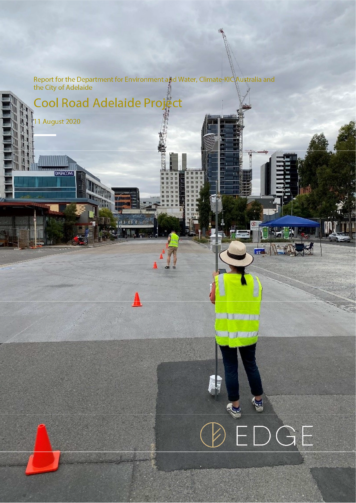Adelaide, 20 August 2020 – On hot summer days, asphalt roads contribute to heating cities and urban areas, known as the urban heat island effect. This can impact the comfort of those using the space such as pedestrians and cyclists. It can also impact retail trade for businesses near urban heat islands and increase energy and maintenance costs for surrounding buildings.
Last summer, the Cool Road Adelaide project tested three cool road surface products on Bowen Street West, monitoring their effects on reducing surface temperature.
The project was delivered by Climate-KIC Australia in partnership with the City of Adelaide, the SA Department for Environment and Water, and supported by Fulton Hogan
The Cool Road Adelaide project is the first in Australia to capture both day and night time surface temperature data and provides evidence that cool road sealants can contribute to temperature reduction on the road surface during the day and into the evening after sunset. Cool road sealants should therefore be considered a tool for contributing to cooler urban landscapes. Combined with the cooling benefits of street trees, targeted irrigation, and other cooling strategies, cool roads would reduce heat generally and the most extreme urban heat temperatures during future heat waves.
Key findings from the study are;
- All three cool road sealants showed a reduced surface temperature when compared to the portion of traditional asphalt road used as a control.
- Cooling demonstrated by each product was 8.65°C (CoolSeal), 4.95°C (JetBloc) and 2.6°C (JetCool) during the day and 4.2°C (CoolSeal), 2.9°C (JetBloc) and 1.5°C (JetCool) during the night.
- New/darker traditional asphalt road nearby was found to be hotter during the day than the cool road sealants, but also 6°C hotter than our control asphalt that was more aged.
- Measuring the impacts of these sealants on air temperature proved challenging and was inconclusive.
- Widespread use of the most effective sealant could generate a near 1°C surface cooling at a whole of city scale. While this level of surface temperature cooling across the urban area may not seem substantial it could significantly change the human comfort level and building energy consumption.
- Modelling of an increase in tree canopy to cover 33% of roads in Adelaide was predicted to achieve a similar level of surface cooling and would be likely to deliver a higher human comfort due to shading and other benefits of trees.
- There was widespread interest in the cool road trial across the community with strong engagement though social media. While survey response numbers were low, the responses were mostly positive with no negative feedback regarding the products.
- All three cool road sealants are road preservation products, 6 months after application they were all seen to be providing a full seal coating of the road surfaces, however, the sealants had begun polishing off the top of the stone aggregate of the existing oxidised asphalt surface. The visual appearance was better when the products were applied onto new asphalt.



